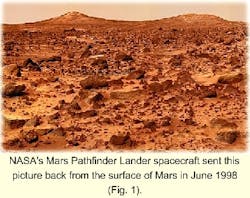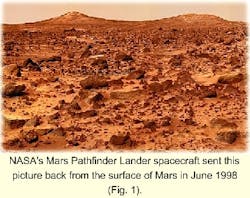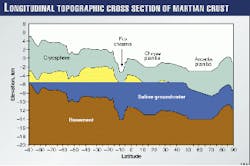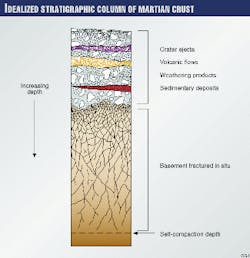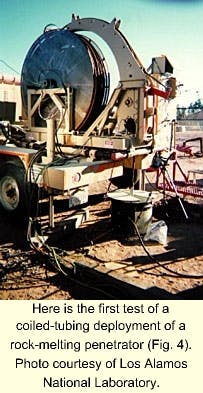Drilling technology for Mars research useful for oil, gas industries
Man is getting closer to setting foot on Mars. And the development of tools to use when he gets there is already moving to the front of technical priority lists.
One area of great importance is finding out of what the inside of Mars consists. That's where the petroleum industry comes in.
Although significant improvements have been made in petroleum exploration technology in the past few decades, the rotary technique that was developed more than 8 decades ago is still used worldwide.
Will this technology be able to meet the demands of the future? Or is the industry in need of a revolutionary drilling technique that allows quicker and more economical access to reserves-a technique that can create a borehole through highly unconsolidated formations; a technique that does not depend on casing or cementing?
The answers are unclear, but potential solutions for the oil and gas industry may lie in technology that the National Aeronautics & Space Administration (NASA) will use for drilling into the surface of Mars (Fig. 1).
NASA's Mars exploration program, despite recent setbacks, presents an unprecedented opportunity for both investigating the possibility of life on Mars and for improving our abilities to support oil and gas demands on Earth. This is an opportunity that warrants the support of both government and industry leaders.
The mission
NASA is developing plans to send sophisticated robotic spacecraft to Mars toward the end of this decade. The plan is to drill to a depth of several hundred meters to search for ground ice, to measure the temperature gradient, and generally to characterize the subsurface in anticipation of deeper drilling activities.
That would provide a foundation for further investigation to seek evidence of extinct or, even extant microbial life on this small, cold planet.
Within 15 to 20 years, NASA may also send manned missions to Mars with the goal of further exploring the planet's surface, both for scientific goals and to determine what resources may be available for in situ use-especially for life support and for the production of rocket propellants.
Drilling to a depth of more than 3 km (where temperatures will be tens of degrees warmer than at the frigid surface) in search of liquid water (only water in the ice or gas phase is stable at the surface) will be a project of great scientific and practical import.
Studies performed by the Lunar & Planetary Institute indicate that brines-a potential source of liquid water essential even for microbial life-may exist at such depths (Fig. 2).
The need for new technology to support the Mars missions presents a unique opportunity for industry experts from around the world to combine their expertise in developing truly revolutionary drilling and analysis technologies that can meet space exploration objectives as well as benefit oil and gas production on Earth (see sidebar).
The need for industry involvement is obvious. For almost 85 years, humans have been probing their planet with machines that can bore more than 10 km deep, and much of the knowledge and experience gained through this work is applicable to the Mars missions.
Unfortunately, the foundation of this earth-based technology-the very powerful machines and large surface facilities that make these drilling techniques possible-is not directly applicable for drilling and subsurface sampling on Mars.
Because size and weight will be a premium on Mars missions, new technologies are needed.
To help focus development initiatives for the advanced space-drilling technology, researchers within NASA and the National Advanced Drilling & Extraction Technologies (NADET) Institute, Boxford, Mass., have proposed the following as an initial goal:
To demonstrate on Earth a completely automated system to produce a stabilized wellbore that is 300 m deep and 8 cm in diameter. Because the technology would be developed as a learning tool, NASA and NADET researchers are seeking a prototype to meet the automation, portability, and power requirements that will be needed for the final robotic mission of drilling to 200 m on Mars. The demonstration is needed within the next 3-5 years.
An earthbound demonstration is essential for any system to be launched into space. However, the advanced capabilities are equally attractive on Earth, with applications ranging from safely drilling a water well through contaminated zones to reach potable water, to economically drilling deep oil or geothermal wells.
Requirements for drilling on Mars
During initial planning workshops, researchers and officials from NASA, the NADET Institute, the US Department of Energy, three national laboratories, and select industry representatives identified 16 technologies that would be required to meet the drilling, downhole evaluation, and safety needs of the Mars missions.
They also agreed that success requires cooperation between NASA, DOE, and industry.
Although the drilling and sampling requirements for Earth and Mars have many differences, they also share many similarities. The 16 technologies identified and their potential benefits to Mars exploration and oil and gas production are covered below.
Drilling systems
Revolutionary drilling methods. Normal rotary drilling operations use jointed pipe and large volumes of drilling fluids for pressure control and cuttings removal that preclude such use on Mars.
Instead, a revolutionary lightweight, fully automated, deep-drilling system is needed for Mars missions. Even under the best of conditions, the system must produce a stable borehole through unknown materials operated by astronauts whose drilling knowledge may be limited.
Or, as in the case of the early unmanned missions, under no watchful eyes at all. That degree of automation, together with other mission constraints, will require a highly innovative drilling system.
For Earth-based applications, a totally automated deep drilling system promises major economic gains and versatility for oil, gas, and geothermal well drilling. It also provides advantages for water-well drilling, scientific drilling, and other mining, construction, and environmental remediation operations.
The attributes required of a Mars drilling system may also benefit the oil and gas industry through savings of time, manpower, capital costs, and environmental resources.
Casingless drilling. Deep sampling on Mars will require methods that eliminate the need for casing because it is simply too heavy to transport by spacecraft. And much of the cost of drilling oil and gas wells could be saved if formations could be stabilized without casing sufficiently to prevent collapse.
Some sort of "case-while-drilling" capability would be required for ensuring a stable bore through all formations (including unconsolidated soil). Perhaps a continuously extruded liner could be used in place of steel, or a stabilization material could be injected into the formation.
Similarly, a drilling system could be suspended on a flexible umbilical, rather than on a string of rigid, screwed-together drill pipe. This would require a torqueless, thrustless drilling head, or a downhole assembly that generates torque and thrust from the bore walls.
In addition to serving as a suspension member, the umbilical could possibly provide power and communications, a fluid for lifting waste material from the hole, and a supply of material for borehole stabilization.
Such a flexible, coiled system must be much simpler than a rigid, conventional system.
Directional drilling systems. The need for new and better directional drilling systems for the oil and gas industry is driven by the need more-efficiently to drain formations with multilateral wellbores. This, coupled with remote sensing and unique logging methods, could prove to be valuable for oil and gas producers.
The requirements for Mars drilling may be similar. While directional drilling may not play as critical a role on Mars, the technology may still have applications.
Microborehole drilling. Even with the development of revolutionary drilling methods, exploratory holes drilled on Mars will be small compared to Earth. Therefore, microborehole drilling will be needed on Mars.
With the advent of multilateral wells on Earth, smaller holes may also play an important role in completing future wells or placing sensors in critical locations to help evaluate production.
Monobore drilling. The drilling of a single borehole from top to bottom will probably be necessary on Mars. Weight restrictions of Mars missions will limit equipment taken there.
On Earth, a well is constructed with several sizes of wellbores, decreasing in size with depth. But a method for constructing a well with a single size of casing would generate tremendous savings in both time and money for oil and gas operators.
Downhole evaluation
Remote sensing. Remote-sensing technologies, capable of indicating changes from the surface and from inside the wellbore, are subjects of much discussion and concern. More information is needed about the formations and conditions into which a drill string is about to penetrate.
Earth-based operations rely to a great extent on previous geological knowledge and weighted fluids for formation control. However, because Mars represents a total wildcat situation, remote-sensing technologies will be critical for success.
Formation characterization. Formation characterization is as important to Mars and Earth operations as remote-sensing technology. Because the search for water and life on Mars are the key issues, a good understanding of Mars lithology will be essential.
Likewise, a thorough understanding of geological formations is essential for companies that are drilling for oil or gas. This information, whether it is gathered through remote sensing or in situ formation analysis, is critical to the success of any well construction effort.
New and better methods for characterizing formations are needed for helping scientists in their search for life, and for optimizing oil and gas drilling operations on Earth.
In situ chemical analysis. The ability to identify various formation fluids in situ is extremely valuable. Samples of formation fluids provide information about the well being drilled and the surrounding reservoir.
This helps plan completion and production methods and helps determine the quality and economics of the hydrocarbon within the formation.
With current methods, the collection and analyses of samples require several days. Accomplishing such tasks in situ would save considerable time and money. Industry scientists and engineers are already working to develop such a process, but new techniques are needed.
This technology would help astrobiologists on the Mars missions to measure the chemical, mineralogical, and physical properties of the strata being penetrated, optimizing the quality of samples returned to the surface for analysis.
Any new techniques developed for use in the Mars missions would most likely have direct application on Earth.
Logging methods. New logging methods are needed for Mars and Earth applications to provide a better understanding of the fluids (ices, in the case of Mars) and formations that are being penetrated.
Like the formation characterization and remote sensing technologies, logging may help Mars explorers find both liquid water and life, if they exist. New logging methods may be necessary for the latter.
Such methods would be extremely valuable to oil and gas personnel in their search for better formation information.
Small-video-camera technology. The use of downhole video cameras for well evaluation is an emerging business. Analysis of oil-bearing formations and trouble spots can be greatly enhanced with downhole video.
Because Mars drilling will most likely use 5 cm or smaller drilling tools, small video cameras will be needed to help scientists better understand the physical characteristics of the formations being penetrated-some of which will be highly brecciated and others that will have high ice content
Seismic geology and lithology analysis. Before drilling on Mars, seismic (or other) analysis of the subsurface geology (Fig. 3) will be required, but the techniques currently used with oil and gas drilling may not be applicable.
New seismic techniques could also greatly enhance operators' abilities to determine the best sites for oil and gas drilling.
Robotics
Robotic drilling systems. Substantial autonomy is critical for Mars applications and is potentially extremely attractive for Earth-based operations too.
The missions that must precede any manned trips to Mars must rely on system autonomy because of the round-trip communication time of tens of minutes and the big gaps in direct communication coverage.
Very capable autonomous systems for space use are now being developed and demonstrated-most notably, the "Remote Agent" system demonstrated in 1999 on the Deep Space One spacecraft.
For earthbound operations, robotic systems provide a potential means of reducing capital and operating costs. Current systems, especially for offshore, cost hundreds of millions of dollars to build and tens of millions to operate.
Since much of the oil and gas yet to be found is deep beneath the oceans, robotic submersible drilling vessels may play an important role in developing these reserves. The technologies needed to accomplish this appear to parallel those needed for robotic missions to Mars.
Remote-control systems. Remote-control systems are basic to any mission to Mars, whether robotic or crewed. And with oil and gas exploration moving into deeper offshore waters, remotely controlled systems could replace large, expensive floating platforms, providing considerable savings for operators.
Equipment and tools
Surface and subsurface safety equipment. Safety is a critical issue for both Mars and earthbound operations. Most oil and gas drilling locations now involve tens or even hundreds of people (for offshore operations), making safety is a major concern.
Whether drilling into unknown formations or dealing with environmental risks, both Mars and Earth operations need the best safety procedures attainable.
Miniaturization of subsurface tools. Miniaturization of subsurface tools may seem more applicable to Mars missions than to Earth operations.
Because of weight restrictions, Mars missions will require miniature tools. This may prove valuable in a variety of Earth applications, especially if casingless drilling systems and other technologies are developed or improved.
Sampling methods
Core sampling. Samples returned from the interior of Mars must be free of contamination introduced at the surface if we are looking for indigenous microbial life.
We must also ensure against the possibility, albeit probably remote, that the samples could be hazardous to Mars astronauts or to Earth's ecosystems, if they are eventually returned to Earth. Because the coring and sampling techniques currently used in the oil and gas industry cannot ensure that level of protection, new methods will be required.
Any new methods developed for use on Mars will have immediate application on Earth in helping to improve the analysis of location, content, and future treatment of oil or gas-bearing formations.
Proposed specifications for Mars drilling
The Mars deep-drilling missions are at an early stage of definition, and mission plans will inevitably mean compromises between scientific aims on the one hand and the requirements of candidate drilling systems on the other.
For both Mars and earthbound operations, a successful drilling system should meet the following specifications:
- Autonomous operation.
- High portability.
- Reliable, uninterrupted progress through all materials, producing a stable borehole.
- Capable of providing periodic, uncontaminated samples.
- Reduced environmental impact.
- Accurate drill-path control.
- Reduced cost to completion of the bore; while cost reduction is less important for the Mars operation, a 50% reduction is the goal for earthbound applications.
These characteristics are desirable for both space and earth applications, but the emphasis will differ by application.
Reduced cost is by far the most important goal for most earthbound drilling. In contrast, given the anticipated total mission cost associated with drilling on Mars, reliable performance, excellent portability, and power requirements are likely to be the most important characteristics for space missions.
The challenge
Successful development of a highly innovative drilling and sampling system for any application will require a deliberate, focused, and creative effort. NASA has no choice but to innovate, whereas the earthbound industry with its massive capital investments has been very conservative, preferring evolutionary progress.
Given enough time and money, one could undoubtedly automate a conventional drilling system for Earth operations. However, today's mature systems offer a poor basis for total automation.
Total automation will require substantial drilling system simplification. Promising technologies must be selected and designed for automation.
The lack of any space-drilling history and the several development phases that a space system would have to pass through before space qualification is achieved means that NASA must adopt an aggressive schedule to develop and prove such an advanced system.
A single aggressive program for developing a totally automated drilling and analysis system for both Mars and Earth would not only contribute to the objectives of the Mars missions, but also spur a much-needed technology leap for oil and gas production.
Thus, there appears to be great potential for a happy synergy between space researchers who need a brand new, enabling technology for Mars exploration and researchers in the oil and gas industry who can see the potential benefits of a 21st century approach to drilling and production.
The transfer of technology between two such partners, and their collaboration in the development of new technology, will justify the investments involved.
The Authors
Steve Streich is a scientific advisor for the research group at Halliburton Energy Services, Duncan, Okla. He has worked on developing downhole tools for Halliburton for 28 years. Streich has a degree in mechanical engineering from Oklahoma State University, Stillwater, with an emphasis on aerospace engineering. He holds 74 patents.
Geoffrey Briggs has served as scientific director of NASA Ames' Center for Mars Exploration, Moffett Field, Calif., since it was formed in 1992. From 1977 to 1990, he served as deputy director and director of NASA's Solar System Exploration Division in the Office of Space Science & Applications at NASA headquarters in Washington, DC.
Prior to serving at NASA, Briggs worked at the Jet Propulsion Laboratory, Pasadena, Calif., on a variety of space exploration projects. He holds a BS and PhD in physics from the University of Durham, England.
James Blacic is a technical staff member in the geoengineering group at Los Alamos National Laboratory, Los Alamos, NM. He has more than 30 years' experience in teaching and research in such areas as geophysics, experimental rock physics, tectonics, and advanced drilling and mining technologies. Blacic holds a PhD in geophysics from UCLA.
Paul Schilte is an advisor for geothermal energy research projects for Shell Oil Co., Rijswijk, The Netherlands. He has 25 years' experience in drilling and well technology and has spent much of his career with Shell in operations and management of company projects in Norway, The Netherlands, and Scotland. He holds a mechanical engineering degree from Delft University, The Netherlands.
Carl Peterson is founder of the Mining & Excavation Research Institute at the Massachusetts Institute of Technology, Cambridge, Mass. He is also a participant in the founding of the National Advanced Drilling & Extraction Technologies Institute, Boxford, Mass.
Peterson received his ScD degree from MIT in 1963 and, after working in industry for a number of years, returned to teach at MIT in 1976. He is an ASME Fellow.
Scientists, engineers teaming up to develop Mars drilling technology
MULTIDISCIPLINARY TEAMS REPRESENTING A CROSS SECTION OF industry and academia have already been organized to support the development of new technology required for the Mars mission.
The science review team, consisting of astrobiologists, molecular biologists, and geoscientists from inside and outside NASA, will specify the scientific objectives and identify the range of unique Martian stratigraphy in which the penetration system must operate and establish specifications for future lab and field tests.
The team includes representatives of Jet Propulsion Lab, Pasadena, Calif.; Lunar & Planetary Institute, Houston; NASA Ames Research Center, Moffett Field, Calif.; Princeton University, Princeton, NJ; and Oak Ridge National Laboratory, Oak Ridge, Tenn.
A technology review team includes NASA space systems engineers and drilling technology experts from Halliburton and Shell, as well as Texas A&M, Jet Propulsion Lab, and the NADET Institute. This team will investigate and evaluate technology options for Mars application, and plan and design the drilling system for use in an Earth-based demonstration.
Los Alamos National Laboratory, the University of Arizona, and NASA Ames Research Center will also assist in this process. Advanced drilling technologies such as the coiled tubing-deployed, rock-melting microdrill under development at Los Alamos National Laboratory (Fig. 4) may be required to meet the Mars drilling objectives.
Other drilling technologies being considered include cable tools, rotary percussion, supercritical CO2 jet, and thermal spallation.
